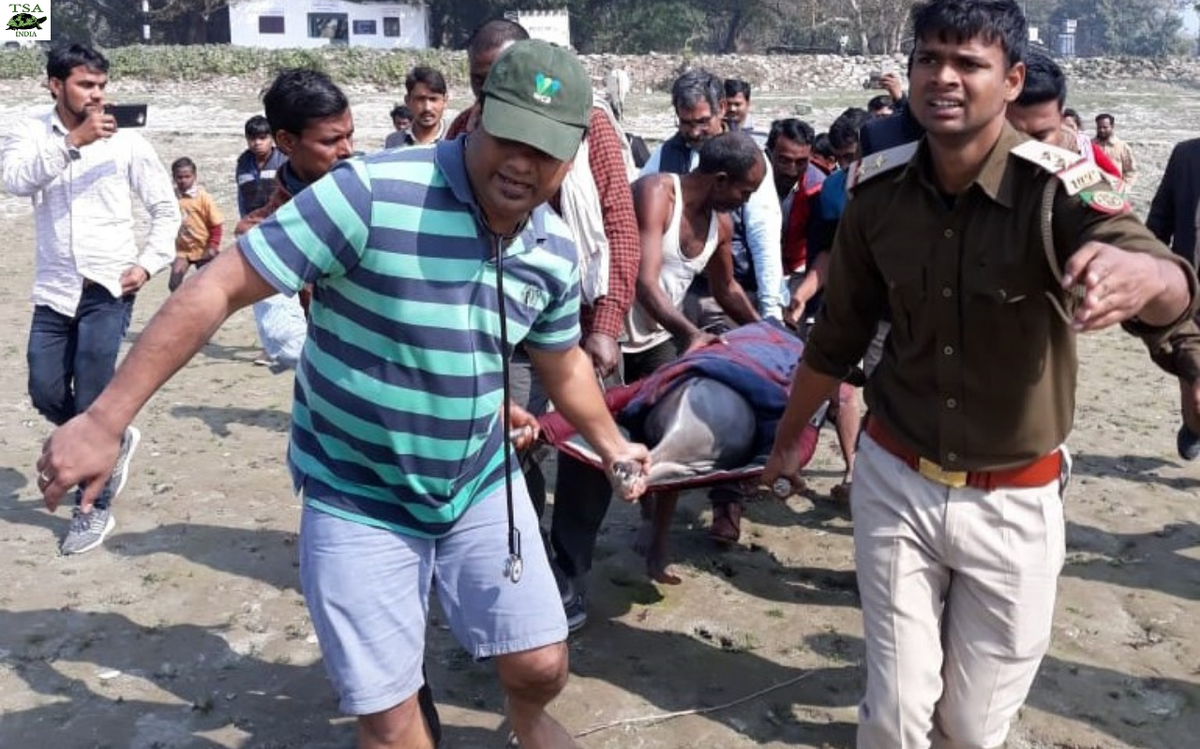
A dolphin being rescued from a canal in the Ganga-Ghagra basin in Uttar Pradesh
| Photo Credit: TSA, India
A recent publication by scientists and researchers has pointed out that 19 Gangetic river dolphins were successfully rescued between 2013–20, from the irrigation canals of the Ganga-Ghagra basin in Uttar Pradesh.
The publication titled ‘Rescuing Ganges river dolphins (Platanista gangetica) from irrigation canals in Uttar Pradesh, North India, 2013–2020‘ not only highlights the capture and relocation methods but also describes the behavioural and demographic details of rescued animals and locations of these canals where the animals had been trapped.
The paper points out that there were 24 rescue operations from 2013–20 and five dolphins have died. “There were 19 successful rescue operations. 14 dolphins were identified as female and 10 as male. The TBL (total body length) of these dolphins was found to be between 128–275cm. Male dolphin body size ranged from 128–195cm, whereas female body size ranged from 190–274cm . Of the five dolphins that died, three had a TBL over 243cm,” the paper said.
The publication emphasised that the development of dams and barrages have severely affected this habitat as dolphins move into irrigation canals where they are at risk of injury or death due to a range of factors, such as rapidly receding waters, heat stroke and human interferences.
Ganges river dolphin is in Schedule 1 of the Indian Wildlife (Protection) Act 1972, Appendix 1 of the Convention on International Trade in Endangered Species (CITES) and Appendix 1 of the Convention on Migratory Species (CMS). The species, also considered the national aquatic animal, is ‘Endangered’ on the IUCN Red List.
Though the Ganges river dolphin is not known to be a gregarious species, the researchers observed and handled at least one adult male and female together on five occasions. “Furthermore, adult females have been seen with a calf on two occasions. These observations suggest that Ganges river dolphins may prefer to live and/or hunt in the pod. The dolphins may either stray into the canal while following prey upstream or get flushed into the canal by a sudden discharge of water from the barrage gates, “the paper added. The researchers also pointed out that the higher proportion of females (n = 14) to males (n = 10) suggests that straying may occur because either larger animals or pregnant female dolphins look for an easier prey base in the canal system.

A dolphin being rescued from a canal in the Ganga-Ghagra basin in Uttar Pradesh
As far as seasonality of the rescue, over 70% of entrapment events were reported either post‐monsoon or during peak winter. This suggests straying incidents are directly related to the release of water into canals during or after monsoons. “The other 30% of dolphins were rescued during peak summer when water levels fall and the minimum water flow is maintained. Among the rescued dolphins, females were found trapped between Sep–May with maximum occurrence during peak winter (Dec–Feb). In contrast, males were mostly recorded post monsoon and during the summer season, with least occurrence in peak winter,” the paper states..
Shaliendra Singh, of Turtle Survival Alliance Foundation India and one of the lead authors of the paper, said that the paper gives data for eight years but in the past ten years 2013-23, 28 dolphins have been rescued. He explained that the rescue of dolphins requires expertise as it is a delicate animal and keeping them alive after the rescue is also a challenge.
“This is a big issue; one average, we rescue two to three animals and another two to three animals may die in canal network of Gangetic basin every year without timely information. Considering that the dolphins are found in the Ganga-Brahmaputra-Meghna Delta, this is a huge problem to monitor this huge area and canal system,” he said.
The other authors of the paper are Arunima Singh, Sreeparna Dutta and Sanjay Srivastava, a senior forect official of Uttar Pradesh cadre.
The publication states that in 2016, the International Whaling Commission’s (IWC) Scientific Committee recognised that both Ganges and Indus river dolphins require prompt and coordinated action to protect them from imminent threats.
In 2017, the IWC created the Asian River Dolphin Task Team (AR‐TT) to identify information gaps and research priorities and develop concerted action for the protection of the Ganges and Indus river species in their range.
One of the key recommendations of the scientists is that IWC AR‐TT recognised the issue of canal entrapment and suggested a focused study be conducted to understand the movements of dolphins across barrages in all countries. The publication recommends a pilot scheme using sonic devices or ‘pingers’ at all three barrages in the Ghaghara subbasin to test their efficacy as deterrents, with a view to expanding their use across the range of present species.